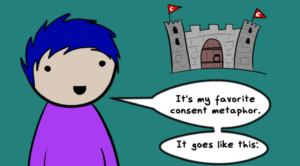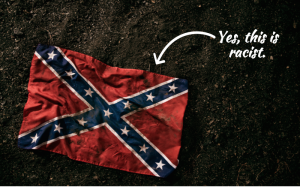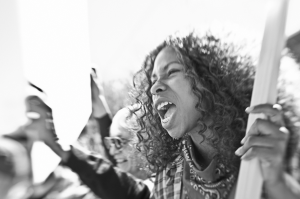
Hands typing on a laptop keyboard.
Originally published on The Establishment and republished here with their permission.
In the last days of 1940, less than a year before the Pearl Harbor bombing that would bring the United States into the Second World War, President Roosevelt delivered a famous address pledging an “Arsenal of Democracy” – weapons and provisions shipped across the Atlantic – for the beleaguered United Kingdom as it fought off the Nazi Blitz.
That phrase’s less militant origins lie in a 1918 essay about World War I by Herbert S. Houston, “The New Day After the War”:
[T]he free press of America, uncensored and responsible only to the people upon whom it depends for support, has proved itself one of the most effective weapons in the arsenal of democracy.
It is this more metaphorical arsenal that I had in mind as I reflected on the devastating results of our presidential election, for it provides a cynosure to lead our course through waters that are suddenly much more turbulent than we anticipated.
What was revealed on Election Night was that a virulently outraged segment of the population – either nakedly bigoted or too willing to ignore the prejudice of their comrades – had been networked together into an ad hoc movement without order or a concrete goal.
We’ve seen the online radicalization of these people take flight over the past several years, via an ugly web of conspiracy theories, harassment campaigns, hate movements, trolling, and the web presence of the old right merging with new media to terrible effect.
The result was a surge of white turnout at the polls for the most unabashedly white nationalist candidate in recent American history.
If anything has been underestimated here, it is the capacity of the Internet to ratchet up the once-isolated rage of the white right and other political fringes, turning it into movements that can topple governments already burdened by the unbearable weight of their ideological fecklessness.
Technocracy is dying a horrible death, yes, but it’s worth understanding the public force whose many knives are everywhere stabbing Caesar.
It is that distributed network, out on that Internet, that too many of us still think of as inconsequentially unreal; it’s created a worldwide movement against the most fundamental principles of democracy.
Trump’s election is but the latest manifestation of the directionless – but networked – rage that saw Brexit occur, that is fueling the rise of Marine Le Pen in France, Alternativ für Deutschland in Germany, fascistic Jobbik in Hungary, the election of Pauline Hanson in Australia, and Sverigedemokraterna’s rise in Sweden.
The Internet, that ultimate manifestation of the very “globalism” these people oppose so strenuously, is what allowed, say, American MRA and Nazi websites to influence the murderous rampage of Anders Behring Breivik in Norway.
But on the level of mass movements, it is linking together political trends across the West, making open racism and other prejudices more acceptable and politically saleable than they have ever been.
From the white nationalist community Stormfront to online comment sections to Breitbart to the Daily Mail’s web presence, there is a vast echo chamber to pressure-cook individual rage into hateful mass movements.
That movement is driven by various prejudices, yes, but what is metastasizing from all that is a movement against democracy itself.
Just before the election, Britain’s tabloid press declared open war on the nation’s independent judiciary after the High Court ruled that Prime Minister Theresa May could not bypass Parliament in invoking the treaty article that would begin the Brexit process.
For upholding a constitutional precedent whose roots go all the way back to the Magna Carta, the Daily Mail dubbed the three judges “enemies of the people,” even using one article to needlessly single out the fact that one of the justices was gay.
Meanwhile, on these shores, we’re well-schooled in how Trump and his movement have demonized the press and the myriad laws that provide some thin layer of protection to women and minorities in this country.
For the Trumpist rank and file, their disenchantment with “the elite” has come to mean disenchantment with all that is supposed to be good about democratic societies: a free press, protection of those not in the majority, and an independent judiciary.
***
That brings me back to the Arsenal of Democracy.
During the last historical period that saw a rise in fascism, that arsenal had to become a literal one as the world spun into a gyre of war – because the countervailing arsenal of fascism was also literal.
It still is today, in its way, though it is invested in the civil police forces of this country.
But the other great force, at least right now, lies in those masses of white Americans who turned out in rural Pennsylvania and Wisconsin and arguably decided the election – just as it does with the people in English suburbs and country towns who moved the needle in Brexit’s direction, or the legions who march with the Islamophobic PEGIDA movement in Germany, or, indeed, the trolls on 4chan who deliberately tried to spread misinformation about our election (like telling Pennsylvania voters that they could now vote by text or tweet).
The simple and unvarnished truth is that in our interconnected world, we are the new Arsenal of Democracy.
Movements like Black Lives Matter have been showing us the way for so long, and too few were listening, even on the left.
While so many of us wrung our hands about Occupy, fewer were asking necessary questions about BLM’s endurance and how it goes from strength to strength.
No small part of that lies in its passion, of course, but its potency also lies in its fluidity. It does not seek territory, but rather flows freely between the Internet and the streets and back again. It is the ultimate un-killable idea.
Our opposition to the murderous rage now wracking the West must take this form as well. The actions of small community groups and local actors mobilizing in their own small patches is more crucial now than it has ever been.
In this darkest of hours, we can only rely on each other to do what needs to be done from here on out.
Especially in the US, we can no longer look to the state to help us, as every fiefdom of the Federal government will pass into the hands of Trump’s saboteurs.
The Democratic Party’s front bench has been cleared; the age of Clintonian centrism is well and truly over. Building a movement behind a young, truly transformative figure in the party will be one of many goals to organize around.
“Whose streets? Our streets!” is a cry that has echoed across countless protests down the decades; more than ever it needs to be applied to the virtual roads that are linking together global hate movements.
Connecting globally and working locally – to heal each other, to provide shelter and resources, to organize resistance and protest, and to get out the vote – is now an absolute necessity.
In the wake of fascism’s latest dawn, we must meet the abstract networks of hate with our own, based on love, faith in our freedoms, and radical inclusion.
We must be the Arsenal of Democracy.
***
More from The Establishment:
- How The Tobacco Industry Exploits LGBTQ People
- We Have To Create A Culture That Won’t Vote For Trump
- Depression-Busting Exercise Tips For People Too Depressed To Exercise
[do_widget id=’text-101′]
Katherine is a sociologist and PhD student at the CUNY Graduate Center in New York City who studies antisocial behavior online. Her work has appeared in Time Magazine, the Guardian, Boing Boing, Rewire, Bitch Magazine, and numerous other outlets; she is also a widely published videogame critic and a weekly columnist at Gamasutra. Her interests are a matryoshka doll of nerdery, through which she strives to make feminism geekier in little ways every day.
Search our 3000+ articles!
Read our articles about:
Our online racial justice training
Used by hundreds of universities, non-profits, and businesses.
Click to learn more




















